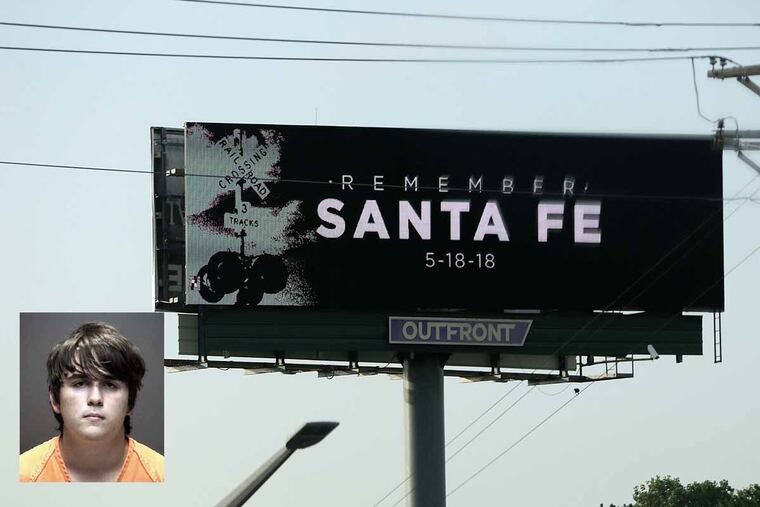Let's face facts: School shootings are inextricably linked to white male privilege | Solomon Jones
In a country that has long portrayed city-dwelling people of color as the main purveyors of violence, that kind of admission would require a fundamental reshaping of who we are.

In the wake of yet another school shooting — this time in Sante Fe, Texas — it's time for America to accept that this brand of gun violence is inextricably linked to white male privilege.
In the 22 school shootings this year where deaths or injuries occurred and suspects have been identified, the majority of suspects have been white males. And with the exception of two school shootings — one of which took place outside Lincoln High School in Philadelphia — the incidents have taken place in suburban or rural environments.
Until America is willing to confront these obvious truths, we won't be able to solve the scourge of school shootings. Because acknowledging that white males in non-urban environments are most likely to commit school shootings would require America to abandon its most treasured stereotypes. That's not something America is willing to do.
>> READ MORE: Don't hold your breath expecting gun law changes after Texas school shooting | Editorial
In a country that has long portrayed city-dwelling people of color as the main purveyors of violence, that kind of acknowledgement would require a fundamental reshaping of who we are. America would have to profile white suburban males with the same fervor it does urban males of color. Police officers would have to claim they fear for their lives in the presence of white rural men and boys. The veil of suspicion that drapes over the lives of males of color would have to be extended to white males, as well.
White male privilege protects would-be school shooters from such scrutiny. But I would argue that the same sense of privilege that protects white males from that kind of heavy-handed profiling is also the underlying cause of many of the shootings.
Sadly, the role of privilege in mass school shootings is not new.
In 2004, the U.S. Secret Service, through its Safe School Initiative, issued a report called "Implications for the Prevention of School Attacks in the United States."
The report examined 37 school attacks and found that 76 percent of the attackers were white males and that almost two-thirds of them came from two-parent families. Despite these advantages — or perhaps because of them — the attackers had a hard time dealing with failure.
>> READ MORE: School shooting may not bring change to gun-loving Texas
"Most attackers appeared to have difficulty coping with losses, personal failures, or other difficult circumstances," the report said. "Almost all of the attackers had experienced or perceived some major loss prior to the attack. These losses included a perceived failure or loss of status …
"In one case, the attacker, who was a former student at the school where the attack occurred, was laid off from his job because he did not have a high school diploma. The attacker blamed the job loss on the teacher who failed him in a senior-year course, which kept him from graduating. He returned to the school a year after leaving the school, killed his former teacher and two students, and then held over 60 students hostage for 10 hours."
This report was written 14 years ago, and the characteristics it describes still hold true for many of today's school shooters. So why has America failed to intervene in the lives of young, mostly white men who fit the profile of school shooters?
The answer, in my view, is white male privilege. That privilege undergirds America's unwillingness to look at would-be shooters as a group who share similar characteristics and motives.
Lawyer and critical race theorist Dr. Tim Golden explains it this way: A school shooting in a place such as North Philadelphia would be attributed to drugs or gang violence and met with calls for more stop and frisk. But school shootings in suburban and rural environments are met with calls to maintain the Second Amendment rights of gun owners.
>> READ MORE: Texas shooting renews debate about American school design
"So here we have the same phenomenon, but radically different responses," Golden told me. "A school shooting that affects whites where the rhetorical and public policy emphasis is on the protection of Second Amendment rights — rights that white men tend to claim — and a school shooting that affects blacks where the rhetorical and public policy emphasis is on the evisceration of Fourth Amendment rights — rights that government routinely disregards as they apply to black people."
In my view, the disparity begins even before the shootings take place, because the very tactics that have helped to prevent school shootings in urban environments are not enacted in suburban schools where such shootings tend to occur.
Philadelphia, for example, has had metal detectors in its schools since 1997. Today, those devices are in place in 50 high schools across the city, according to School District spokesman Lee Whack. In addition Philadelphia has deployed school police officers for 40 years.
The officers are assigned based on an analysis of a variety of factors, including number of serious incidents, enrollment, and physical size of the school.
I doubt we'll see such common-sense measures in the suburban schools attended by would-be mass shooters, because that would impact their privilege.
However, we must do something, because privilege should never trump lives.
Solomon Jones is the author of 10 books. Listen to him weekdays from 10 a.m. to noon on Praise 107.9 FM. sj@solomonjones.com: @solomonjones1